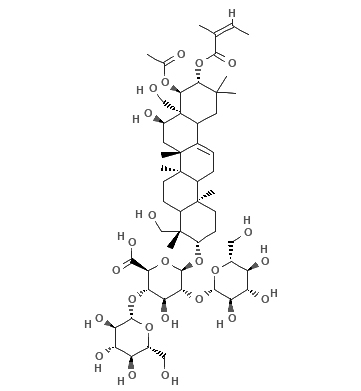Saponin
Tea saponins could modify the rumen fermentation and inhibit the release of methane and ammonia, which may be beneficial for improving nutrient utilization and animal growth.
Inquire / Order:
manager@chemfaces.com
Technical Inquiries:
service@chemfaces.com
Tel:
+86-27-84237783
Fax:
+86-27-84254680
Address:
1 Building, No. 83, CheCheng Rd., Wuhan Economic and Technological Development Zone, Wuhan, Hubei 430056, PRC
Providing storage is as stated on the product vial and the vial is kept tightly sealed, the product can be stored for up to
24 months(2-8C).
Wherever possible, you should prepare and use solutions on the same day. However, if you need to make up stock solutions in advance, we recommend that you store the solution as aliquots in tightly sealed vials at -20C. Generally, these will be useable for up to two weeks. Before use, and prior to opening the vial we recommend that you allow your product to equilibrate to room temperature for at least 1 hour.
Need more advice on solubility, usage and handling? Please email to: service@chemfaces.com
The packaging of the product may have turned upside down during transportation, resulting in the natural compounds adhering to the neck or cap of the vial. take the vial out of its packaging and gently shake to let the compounds fall to the bottom of the vial. for liquid products, centrifuge at 200-500 RPM to gather the liquid at the bottom of the vial. try to avoid loss or contamination during handling.
Hum Exp Toxicol.2017, 36(11):1169-1176
Korean j.of Pharm.2017, 70-76
Agriculture.2024, 69(3):140-148.
Molecules.2023, 28(13):4971.
Molecules.2018, 23(3):E615
Processes 2021, 9(5),894.
J Agric Food Chem.2021, 69(14):4210-4222.
J Ethnopharmacol.2020, 249:112396
Inflammation.2015, 38(4):1502-16
Drug Des Devel Ther.2020, 14:5189-5204.
Related and Featured Products
Animal Feed Science & Technology, 2005, 120(3-4):333-339.
Effect of tea saponin on rumen fermentation in vitro.[Reference:
WebLink]
The present study was conducted to investigate the effect of tea Saponins (TS) on ruminal fermentation in vitro using gas syringes as incubators.
METHODS AND RESULTS:
The TS were added at levels of 0, 2, 4, 6 and 8 mg against 200 mg mixture of corn meal and grass meal (1/1, w/w) in rumen fluid. In vitro gas production (GP) was recorded and methane concentration was determined at 3, 6, 9, 12 and 24 h incubation. After 24 h, the incubation was stopped and the inoculants were determined for pH, ammonia-N, volatile fatty acids (VFAs), protozoa counts and microbial protein yield. The GP was increased with the increasing level of TS except 8 mg at 24 h, which kept little change from that of the control. Methane concentration was decreased at all levels of TS at each incubation time. At 24 h incubation, inclusion with 2, 4, 6 and 8 mg of TS decreased methane concentration by 13, 22, 25 and 26%, respectively. The pH of ruminal fluid was slightly lower at 4 and 6 mg TS, but all values were in the normal range. Ammonia-N concentrations decreased significantly (P < 0.01) when the TS were included. Concentrations of individual and total VFAs were not significantly effected by TS addition. The TS significantly inhibited the protozoa growth in ruminal fluid (P < 0.01). At 24 h incubation, protozoa counts were reduced by 19, 25, 45 and 79%, respectively at levels of 2, 4, 6 and 8 mg of TS compared to that in control. The microbial protein was enhanced with the TS addition except 2 mg level, and reached 1.92, 2.36 and 2.61 mg/mL with addition of 4, 6 and 8 mg TS, compared to 1.50 mg/mL in control.
CONCLUSIONS:
It is suggested that TS could modify the rumen fermentation and inhibit the release of methane and ammonia, which may be beneficial for improving nutrient utilization and animal growth.
Chemical & Pharmaceutical Bulletin, 1999, 47(12):1759-1764.
Bioactive saponins and glycosides. XV. Saponin constituents with gastroprotective effect from the seeds of tea plant, Camellia sinensis L. var. assamica Pierre, cultivated in Sri Lanka: structures of assamsaponins A, B, C, D, and E.[Reference:
WebLink]
The Saponin fraction from the seeds of the tea plant, Camellia sinensis L. var. assamica PIERRE cultivated in Sri Lanka, was found to show a potent protective effect on gastric mucosal lesions induced by ethanol in rats.
METHODS AND RESULTS:
Nine new acylated polyhydroxyoleanene-type triterpene oligoglycosides called assamSaponins A-I were isolated from the active Saponin fraction together with three known Saponins, theaSaponin E(1) and E(2) and camelliaSaponin B(1). The structures of assamSaponins A-E were elucidated on the basis of chemical and physicochemical evidence.
CONCLUSIONS:
TheaSaponin E(1) exhibited potent gastroprotective activity.



